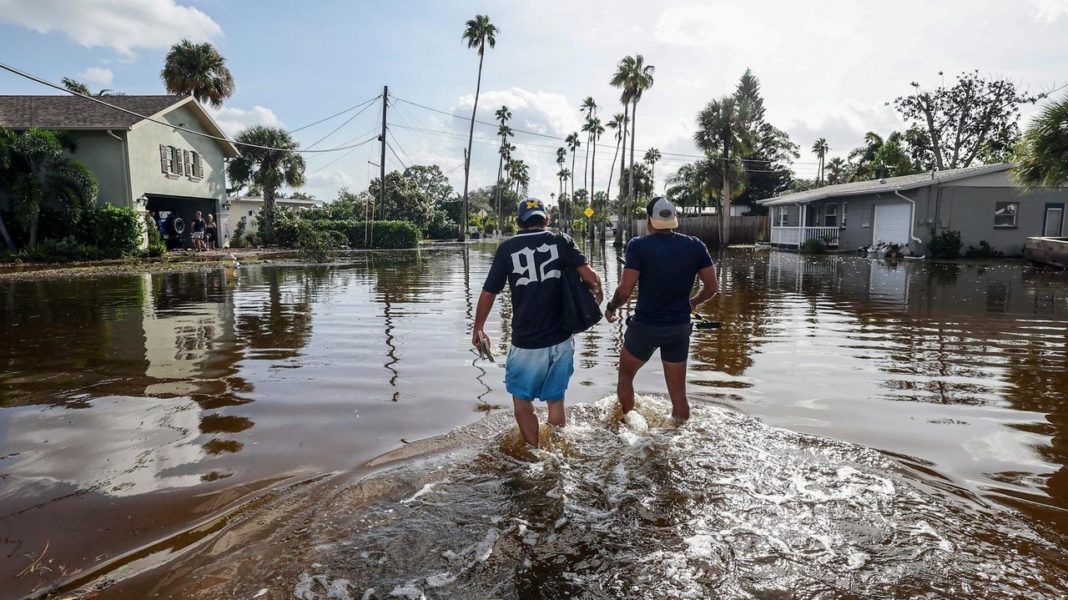As Hurricane Helene barreled across the Gulf of Mexico, many of us did what we usually do. We watched radar depictions of the storm as it mushroomed, awaiting the inevitable count-up from hurricane trackers and meteorologists. Sure enough, Helene became a Category 1, grew to a 2, graduated to 3, and peaked as a catastrophic Cat 4, the intensity with which it slammed into Florida on Thursday night.
Then we discovered, as we invariably do these days, that the wind speed those categories measure is only part of the story. In fact, the wind might be a lesser part of the story.
With hurricanes, especially nowadays, it’s also very much about the water.
Water kills more people than wind in hurricanes, and creates more of the damage that contributes to the modern proliferation of $1 billion storms. And what differentiates today’s hurricanes is the volume of water they are dropping.
We know why this is true — warmer ocean waters that feed storms and warmer air that can hold more moisture. That’s a powerful argument that we need a better way to rate these behemoths than the old Saffir-Simpson Scale that charts maximum sustained wind speeds and is the current key measure.
We need a rating system that also evaluates rainfall and storm surge to better direct attention toward the volume of water that will inundate us.
Lately, we have seen over and over the many destructive forms that such inundation can take; Helene was the eighth Category 4 or 5 storm that has struck the United States since 2017 — as many as hit our nation in the previous 57 years.
We’ve seen ocean water surge past our feeble attempts at resistance. We’ve seen rivers pour through neighborhoods after cresting banks and crashing through dams. We’ve seen deluges overwhelm drainage systems built for calmer times, and undermine houses built on the sides of hills and valleys.
Not only does water heavily damage roads, bridges, cars, homes and other structures, it makes rescues dicey and stalls needed repairs to everything from streets to the electric grid.
The frightful images from Helene were sadly familiar. Mobile homes pushed around and flooded out in Florida. Cars submerged mid-window in the Atlanta suburbs. Household goods floating down a street in Asheville, North Carolina, more than 450 miles from Big Bend where Helene came ashore.
The local implications are ominous.
In terms of readiness, Long Island is no better prepared than most of the places whose devastation has played across our screens. As we saw in the North Shore rainstorm in Suffolk County last month, not to mention other severe downpours of late, our drainage systems can’t handle the kind of rain we’re getting, our dams can’t hold back the force of the water, and we don’t have enough natural spaces in some places to absorb the sheets of precipitation.
As Helene approached landfall Thursday, the Long Island Regional Planning Council released a report on the businesses, jobs and revenues at risk from storm flooding along the South Shore. The topline conclusion: Some 5,903 businesses with 70,214 employees doing more than $7 billion in annual sales are at very high risk, which it defines as being in the Federal Emergency Management Agency’s 1-in-100-year flood zone. Given the recent spate of 1-in-1,000-year events — the classification for the rainfall in Asheville, for example — those odds don’t look quite so long anymore.
Our region has been beset by big storms before. Sooner or later, one of these new monsters will come to us again. The sooner we stop talking about the preparations we should take, and actually start making them, the better.
Columnist Michael Dobie’s opinions are his own.


